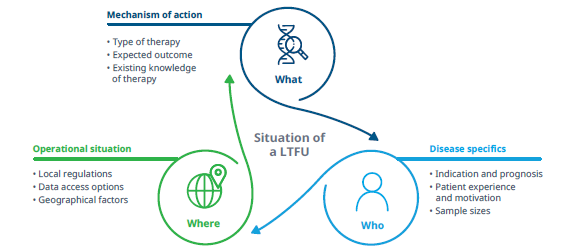The study of gene therapy is taking the clinical research industry by storm with tremendous growth and interest from all stakeholders. In 2023, venture capital funding reached $3.4Bn, and a record number 406 industry-sponsored clinical trials started and 76 cell and gene therapies launched globally. It is mandatory to monitor patients who receive gene therapy treatment over extended periods and there is still much to learn about how to best monitor for delayed adverse events and sustained efficacy.
To do so, many regulatory agencies, including the U.S. Food and Drug Administration (FDA) and European Medicines Agency (EMA), have developed guidelines based on product characteristics regarding the design and key data elements of required long-term follow-up (LTFU) studies. Depending on the type of gene therapy and the population being treated, these LTFU studies are required to run from five to 15 years - presenting a breadth of challenges for study sponsors with a unique layer of considerations for emerging biotech companies.
Given much of the ground-breaking innovation in gene therapy, and 50 percent of all trial activity, comes from biotech companies, it is critical to understand the unique challenges these smaller sponsors face.1 And, as the landscape evolves, challenges will grow, requiring biotech sponsors to rely on innovative and agile patient-centered approaches and technologies to successfully conduct LTFU studies in gene therapy and reduce burden on patients and sites involved.
Key considerations for long-term follow-upGiven the remaining uncertainty around the long-term safety and efficacy of gene therapies, appropriately extended follow-up is critical. Common regulations and standards have been established regarding LTFU in gene therapy. Some of these variable aspects in the guidance for LTFU impact biotech sponsors' development and monitoring strategies differently, and therefore, should be considered early when therapies are in development and prior to launching first-in-human studies.
Elements to consider in long-term follow-up study design
When working in gene therapy, as in other areas of development, biotech sponsors will always have a strong underlying pressure to ensure what typically may be a single breakthrough asset “makes it.” As the livelihood of the company can be at stake for any given asset, these sponsors always need to carefully weigh out scientific pursuit versus progressing the asset through development for the sake of business goals.
When biotech sponsors are focused on developing at most one or two therapies at any given time, it may be hard to create efficiencies needed, given financial reasons and limitations in consolidating multiple trials into one long-term trial protocol. Through standard approaches, these sponsors may have to transition each single trial into its own LTFU – increasing costs and potentially operational effort.
Furthermore, development pathways for each asset for these companies can vary greatly based on the investigational treatment or set business objectives. Biotech companies may undergo a merger or varying licensing arrangements that impacts the strategic direction of therapy development and related LTFU design down the road. Depending on the opportunities within the industry to self-develop or to partner in a future state, planning for LTFU at the very start of clinical development can be difficult, requiring agility and solutions to pivot, if needed.
Biotech sponsors dedicate a great amount of time, resources and focus to gain insights on the workings of their asset, such as mechanism of action or a cellular-level understanding. It is also important to keep patients in mind and consider how to reduce their burden to participate in the study. Given the duration of follow-up required after gene therapy, the patient burden can become unmanageable over extended periods, leading to noncompliance or withdrawal from the study, thus undermining data quality and the objectives of the LTFU trial. One of the most tangible considerations biotech sponsors need to keep in mind is planning LTFU around long, unpredictable patient journeys due to the considerable duration of time required. Sponsors must think about accommodating changes in a patient’s overall health status, the potential for caregivers or family life changes, relocation needs, or changes in daily living.
Innovative LTFU solutionsBiotech sponsors must think through distinct operational, financial, tactical and patient-specific aspects when planning the LTFU phase of development. There are differentiating solutions—going beyond standard approaches—that can be helpful to consider in the early stages of therapy planning to help increase the likelihood of LTFU success.
The use of remote and digital tools that can collect data may increase patient engagement and lessen patient burden throughout the long monitoring period. This can improve compliance and data quality in LTFU studies. Tech-enabled tools could include telehealth visits, mobile research services, and connected devices which remotely monitor data, allowing patients to participate without necessitating travel to an office visit. These innovative approaches can help foster patient retention by decreasing onsite evaluations while still accumulating the long-range data needed to advance the field. For these reasons and more, hybrid trials with decentralized elements may be an optimal solution.
Along with decentralized solutions, sponsors will need access to expert knowledge of LTFU design and execution—considering all perspectives and components at play, including clinical, regulatory, data collection efficiencies, and patient-focused logistical and other needs.
In this exciting space of therapeutic growth and interest, biotech companies will fare well to take a closer look at the unique challenges to their asset development, specific to LTFU early in the planning process. Working through clinical issues, data needs, study endpoints and safety monitoring will help to increase efficiency in the clinical development of these exciting therapies, accelerating their availability to patients in need.
Please contact me directly to discuss how the IQVIA Biotech team can guide you through gene therapy LTFU planning and execution.
REFERENCES
1IQVIA Institute for Human Data Science. Strengthening Pathways for Cell and Gene Therapies: Current State and Future Scenarios. March 2024. Available from www.iqviainstitute.org

 Search
Search